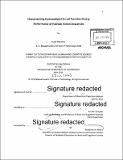| dc.contributor.advisor | Ann M. Graybiel. | en_US |
| dc.contributor.author | Martiros, Nuné | en_US |
| dc.contributor.other | Massachusetts Institute of Technology. Department of Brain and Cognitive Sciences. | en_US |
| dc.date.accessioned | 2017-01-12T18:33:28Z | |
| dc.date.available | 2017-01-12T18:33:28Z | |
| dc.date.copyright | 2016 | en_US |
| dc.date.issued | 2016 | en_US |
| dc.identifier.uri | http://hdl.handle.net/1721.1/106437 | |
| dc.description | Thesis: Ph. D., Massachusetts Institute of Technology, Department of Brain and Cognitive Sciences, 2016. | en_US |
| dc.description | Cataloged from PDF version of thesis. | en_US |
| dc.description | Includes bibliographical references (pages 101-111). | en_US |
| dc.description.abstract | The striatum is the largest nucleus in the basal ganglia and the recipient of dense dopamine input. Multiple cortico-basal ganglia-thalamic loops are thought to function together during the learning and performance of reinforced behaviors, with the dorsolateral circuit being particularly critical for the learning of habitual chains of action sequences. However, how this circuit works to generate such behavior is poorly understood. To explore the nature of striatal neural representations during learned action sequences, I designed a task targeted at disambiguating movement-related responses from habit representations in striatum. In combination with this task, I employed electrophysiology and optogenetics techniques to characterize task-related neuronal activity in the corticostriatal circuit. I found that, unlike in motor cortex, neurons in striatum did not respond simply to particular individual actions, but responded preferentially at the initiation and termination of learned action sequences. These experiments provide a test for the existence of a generalized striatal signal marking the start and end of units of habitual behaviors which may be produced with the contribution of striatal interneurons, providing a mechanism by which striatum can control the encoding and performance of chunked action sequences. In a separate set of experiments, I explored the effect of dopamine depletion on local field potential oscillations in the same region of striatum. My goal was to investigate the interaction between abnormal oscillations caused by dopamine depletion in Parkinson's disease and the functional task-related oscillations that normally occur in healthy striatum. Against our expectations, I found that local unilateral dopamine depletion in dorsolateral striatum did not result in changes in pre-task baseline strength of oscillations, but rather in the overexpression of the normal task-related oscillations. These studies add support to theories of striatal function and dysfunction that emphasize selective network modulation by learned behaviors. | en_US |
| dc.description.statementofresponsibility | by Nuné Martiros. | en_US |
| dc.format.extent | 111 pages | en_US |
| dc.language.iso | eng | en_US |
| dc.publisher | Massachusetts Institute of Technology | en_US |
| dc.rights | M.I.T. theses are protected by copyright. They may be viewed from this source for any purpose, but reproduction or distribution in any format is prohibited without written permission. See provided URL for inquiries about permission. | en_US |
| dc.rights.uri | http://dspace.mit.edu/handle/1721.1/7582 | en_US |
| dc.subject | Brain and Cognitive Sciences. | en_US |
| dc.title | Characterizing corticostriatal circuit function during performance of habitual action sequences | en_US |
| dc.type | Thesis | en_US |
| dc.description.degree | Ph. D. | en_US |
| dc.contributor.department | Massachusetts Institute of Technology. Department of Brain and Cognitive Sciences | |
| dc.identifier.oclc | 967342608 | en_US |
